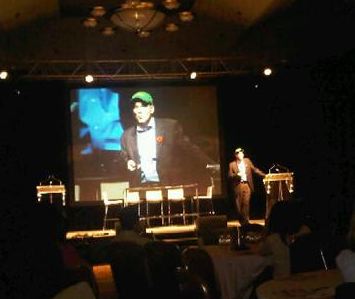So I’m sitting at Starbucks at 3, and I’ll be on stage in about 33 minutes. My presentation looks perhaps like a hotdog long before it takes that edible, if somewhat phallic, shape. Despite my morning’s panic attack, missing a flight and driving the 7 hours to Boston, I manage to catch YouTube Hall-of-Famer Michael Buckley as I pass his town. Sadly he has “a doctor’s appointment” that precludes a quick spanking or whatever YouTubers do when they meet.
It’s 3:03 as I reorder slides, fundamentally changing my entire presentation (shown below on Slideshare) I can’t help but get distracted by two nervous looking band members who appear to be meeting a new digital marketer consultant. “Our last guy, um, got really busy with school,” says Shaggy (his real name is being withheld because I don’t know it). The consultant begins to LAY IT ON THICK. Total bullshit, coated with a thick creamy topping of arrogance and a faux-pedantic snobbery crowning it all like an overly marinated cherry on top.
The topic of viral video comes up, and my face begins to literally contort as I hear the crap this guy’s advising. I couldn’t control my face. I could see some gal looking at me, and then over at them… making the connection. But I can’t help myself. When Shaggy says “I’m not willing to lose my integrity to get 3 million views on YouTube,” I think seriously about coming to his rescue. But something about this consultant strikes me as odd and dangerous. He’s far too assertive, simplistic, narcissistic, simplistic and repetitive (seems we loathe that in others that we resent in ourselves).
As I’ve finally shifted back to my presentation, literally changing the entire thesis at this point with minutes to spare, the consultant BARGES out the door of Starbucks leaving Shaggy and Scooby stunned. Again I decide to go to their rescue, hold their hand, and tell them that one need not compromise their virtues to go viral… I’ll even volunteer. But just like a dream ending abruptly, they vanish. Come to think of it, maybe it was a dream. No… I’m pretty sure it was real.
Then I gave this presentation below. To show that humor is hard to categorize because of its subjectivity, I did a live vlog (seen at the end of this video) where I followed the 102nd rule of “winning over an audience.” I secretly maligned them using a stage whisper. I was actually kinda bummed out they laughed, which is not what I expected after reading this Joel Warner Wired article that put this on my rader (and created an obsession for me).
Now for the preliminary findings, and a BIG thanks to Alexis, Kiddsock and Will Reese, as well as other contributors!


